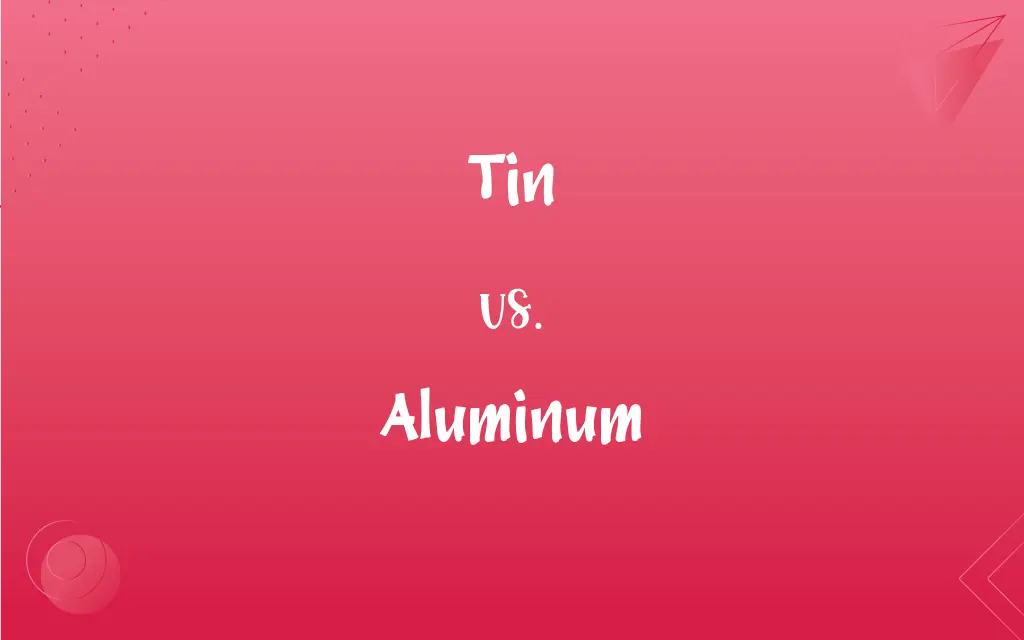Tin vs. Aluminum: What's the Difference?
Edited by Janet White || By Harlon Moss || Updated on October 23, 2023
Tin is a soft, silvery-white metal (Sn on the periodic table), while aluminum is a lightweight, silver metal (Al on the periodic table).

Key Differences
Tin, represented as Sn on the periodic table, has been used since ancient times, often in alloys. Aluminum, represented as Al, is a more recently exploited metal known for its light weight and resistance to corrosion.
While tin has a silvery-white appearance and is soft in nature, aluminum boasts a shiny silver finish and is known for its malleability and ductility.
Tin's primary use historically was in the production of bronze, an alloy of tin and copper. Aluminum finds extensive use in transportation, construction, and packaging due to its light weight and strength.
Corrosion resistance is a key feature of aluminum, making it suitable for many outdoor applications. Tin, on the other hand, is often used as a coating for other metals to prevent corrosion.
Both metals conduct electricity, but aluminum is preferred in electrical applications because of its combination of conductivity and weight advantages over heavier metals, including tin.
ADVERTISEMENT
Comparison Chart
Element Symbol
Sn
Al
Appearance
Soft, silvery-white
Lightweight, shiny silver
Historical Use
Producing bronze (alloy of tin and copper)
Transportation, construction, packaging
Corrosion Resistance
Used as a coating to prevent corrosion in other metals
Naturally corrosion-resistant
Electrical Conductivity
Conducts electricity but less preferred
Widely used due to its conductivity and light weight
ADVERTISEMENT
Tin and Aluminum Definitions
Tin
A metal used in making bronze.
Ancient civilizations discovered that adding tin to copper produced bronze.
Aluminum
A chemical element with symbol Al.
Aluminum's atomic number is 13 on the periodic table.
Tin
Often used as a protective coating.
Tin cans have a thin layer of tin to prevent rusting.
Aluminum
A metal known for its corrosion resistance.
The fence is made of aluminum to withstand the elements.
Tin
A material known for its malleability.
Tin can be rolled into very thin sheets.
Aluminum
A lightweight, silver-colored metal.
The airplane's frame is made of aluminum for weight savings.
Tin
A soft, silvery-white metal.
The old toys were made of tin.
Aluminum
Commonly used in transportation and packaging.
Many soda cans are made of aluminum.
Tin
A chemical element with symbol Sn.
Tin's atomic number is 50 on the periodic table.
Aluminum
A good conductor of electricity.
Power lines often use aluminum due to its conductive properties.
Tin
Symbol Sn A crystalline, silvery metallic element obtained chiefly from cassiterite, and having two notable allotropic forms. Malleable white tin is the useful allotrope, but at temperatures below 13.2°C it slowly converts to the brittle gray allotrope. Tin is used to coat other metals to prevent corrosion and is a part of numerous alloys, such as soft solder, pewter, type metal, and bronze. Atomic number 50; atomic weight 118.71; melting point 231.93°C; boiling point 2,602°C; specific gravity (gray) 5.77, (white) 7.29; valence 2, 4. See Periodic Table.
Aluminum
A silvery-white, ductile metallic element, the most abundant in the earth's crust but found only in combination, chiefly in bauxite. Having good conductive and thermal properties, it is used to form many hard, light, corrosion-resistant alloys. Atomic number 13; atomic weight 26.9815; melting point 660.32°C; boiling point 2,519°C; specific gravity 2.70; valence 3. See Periodic Table.
FAQs
What is aluminum's symbol on the periodic table?
Aluminum's symbol is Al.
Is tin used in the production of bronze?
Yes, tin is combined with copper to produce bronze.
What gives aluminum its corrosion resistance?
A protective oxide layer forms naturally on aluminum's surface.
How are tin and aluminum recycled?
Both metals can be melted down and reformed into new products, making recycling efficient.
Is tin a good conductor of electricity?
While tin does conduct electricity, it's not as efficient as metals like copper or aluminum.
What is tin's symbol on the periodic table?
Tin's symbol is Sn.
Why is aluminum popular in aircraft manufacturing?
Aluminum is lightweight and strong, making it ideal for aircraft.
Is tin magnetic?
No, tin is not magnetic.
In what products might I encounter tin?
Tin is used in products like solder, pewter, and some glass-making processes.
Are aluminum and tin safe for food storage?
Both metals are used in food storage; however, they are typically coated or alloyed to ensure safety.
Which is more abundant in Earth's crust, tin or aluminum?
Aluminum is more abundant than tin in the Earth's crust.
Which is lighter, tin or aluminum?
Aluminum is lighter than tin.
Can tin resist corrosion?
Tin can resist corrosion and is often used as a protective layer for other metals.
What is the primary ore for tin extraction?
The primary ore for tin extraction is cassiterite.
What is the primary ore for aluminum extraction?
Bauxite is the primary ore for aluminum extraction.
Are tin cans made entirely of tin?
No, "tin cans" are usually made of steel but coated with a thin layer of tin.
Is aluminum expensive to produce?
Initially, aluminum was expensive, but the Hall-Héroult process significantly reduced its cost.
Can aluminum be magnetized?
No, aluminum isn't magnetic and cannot be magnetized.
Why is aluminum used in power lines?
Aluminum combines good electrical conductivity with light weight.
Was tin historically used in pewter items?
Yes, pewter is primarily composed of tin.
About Author
Written by
Harlon MossHarlon is a seasoned quality moderator and accomplished content writer for Difference Wiki. An alumnus of the prestigious University of California, he earned his degree in Computer Science. Leveraging his academic background, Harlon brings a meticulous and informed perspective to his work, ensuring content accuracy and excellence.
Edited by
Janet WhiteJanet White has been an esteemed writer and blogger for Difference Wiki. Holding a Master's degree in Science and Medical Journalism from the prestigious Boston University, she has consistently demonstrated her expertise and passion for her field. When she's not immersed in her work, Janet relishes her time exercising, delving into a good book, and cherishing moments with friends and family.































































